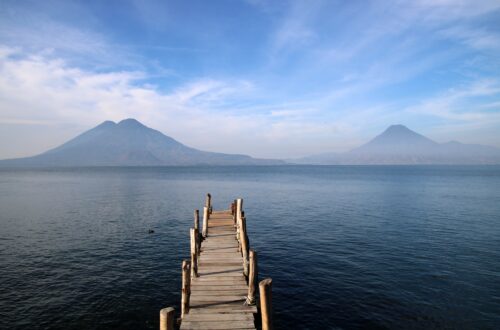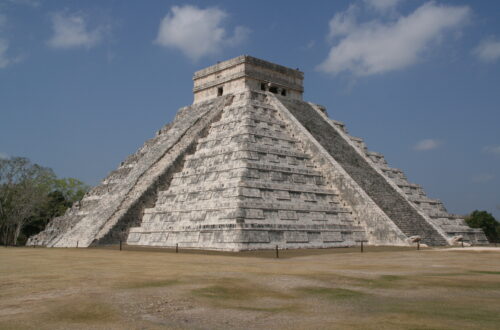
Curaçao, Dutch Caribbean
Itinerary: Willemstad – Band’abou – Willemstad & around
Willemstad
The only reason for getting up early on a Saturday morning is to go on a trip. To the Caribbean this time. After a ten hour flight I arrive at Hato, the airport of the island of Curaçao, which is part of the Kingdom of the Netherlands. It’s 4 p.m. local time. When flying in you can see the island from above, beautifully set amidst the blue of the Caribbean Sea.
Hato is only a small airport and my plane is the only aircraft of size. Fortunately, passing customs and collecting the luggage go quickly. I pick up my rental car (a beige Toyota Corolla) and I head for my hotel in Willemstad, the capital of Curaçao. From the airport, it’s a matter of driving down ‘the road to Hato’ (how appropriate) and turning right at the end, at Piscadera Bay. After checking in I have to wait a little while (‘room inspection’), but at seven I can finally take a shower. According to Dutch time it’s already midnight, so for local standards I go to bed early.
The next morning after breakfast (in the open air restaurant of the hotel) I drive to Willemstad. Unintentionally (either because I’m not familiar with the place yet, or not paying attention) I end up on the Juliana Bridge, the tens of meters high bridge over the St. Anna Bay and the most important connection between the districts of Punda on the eastern quay and Otrobanda on the western quay of the bay. On top of the bridge you have a great view over Willemstad. Unfortunately, you can’t stop in the middle of the bridge to capture that image.

I park the car in Punda, next to the covered market. From there I walk down the photogenic center of Willemstad, which is formed by Punda and Otrobanda (literally: on the other side). I walk down the Handelskade, the widely known landmark of Curaçao with it’s colored facades, and ocross the Emmabrug, a unique pontoon bridge between Punda and Otrobanda. I take a look at Fort Amsterdam, which houses the residence of the governor and various government agencies, and the two old forts at the beginning of the Sint Anna Bay: the Riffort and the Waterfort. I stroll down the narrow streets of Punda, with typical Dutch names such as Breedestraat, Heerenstraat and Keukenstraat, and along the quay wall of the Waterfort (‘de Boogjes’), with restaurants with their terraces by the sea.
Willemstad has a compact center and has a small village feel. It all seems much smaller than on my detailed map. For example, on the map Waaigat looks like a large lagoon in the middle of an urbanized area, but in reality it is more like a pond in the middle of a village. After drinking coffee on the Wilhelminaplein, I walk past the floating market, where fruit traders from Venezuela sail every day to sell their wares. From there I return to the Handelskade, with its photogenic yellow, blue, red and green facades. Here I sit down at a terrace to have lunch.
The weather is as it should be in the tropics. Meaning bloody hot. Fortunately, it’s almost always windy on the island and together with the occasional cloud this makes the high temperature bearable. After seeing all of downtown, I drive to Fort Nassau. This fort is now a restaurant from which you look out over the Schottegat (the large bay near Willemstad) and (less picturesquely) the Isla oil refinery. The outdated refinery causes many environmental and health problems in Curaçao, but also provides employment for the local community.
Next I take the ring road and drive north out of the city. As compact as the center of Willemstad is, so expansive are the suburbs. Lots of low-rise buildings, small houses and bungalows in pastel colors. Along the mostly poorly maintained roads are obscure shops and bars. This is not the Curaçao from the holiday brochures, but the actual Curaçao, where no less than fourty percent of the population lives in poverty.
North of Willemstad a small road leads to the north coast. It’s a road full of potholes and bumps, but it’s worth it. The road ends at Playa Kanoa, where the Caribbean Sea, encouraged by the ever-present trade winds, crashes fiercely against the rocky coast. The landscape here is rugged, with low vegetation and many cacti. Just like Willemstad, a great place to shoot beautiful pictures.

On the way back I stop at a few old country houses of former plantation owners. By the end of the afternoon I’m back at the hotel and I take a dive into the pool. Time to relax after a full sightseeing day. A day that I finish at Captain Bligh’s Bar, named after the captain of the vessel Bounty (known from the film classic Mutiny on the Bounty), who also besieged Curaçao for a while. A cold beer and the sun sinking into the Caribbean Sea. Got the picture?
The next day I start slowly with breakfast, coffee and some reading. Then it’s already time for lunch, for which I visit a local restaurant, Golden Star, where they serve huge portions of tasty Caribbean cuisine. I’m adjusting my pace to the slow pace at which everything is going here in the Caribbean. I spend some time at the beach or the hotel pool, take a shower, have an Amstel Bright (an extremely popular beer in Curaçao) and read a bit.
Band’abou
The next day I head out for a tour of Band’abou. Band’abou is the name given to the entire area west of Willemstad. The part east of Willemstad is called Band’ariba. So literally ‘left side’ and ‘right side’. Once outside of Willemstad, Curaçao consists exclusively of Kunuku, meaning countryside. There is one main road towards the western tip of the island (appropriately called ‘the road to Westpoint’) and a road back south of it, so that you can drive a kind of a circle around the island.
The environment is rugged and hilly. In a few places you can leave the main road towards the north coast of the island, for instance at San Pedro and a little further on, at Boka Tabla. Here the waves hit the rocky coast in a spectacular way. You can also walk into a kind of cave here, where the seawater comes in with the same speed as it hits the rocks outside. Frankly, it’s a little scary… A little later I pass a restored kunuku cottage, a typical laborer’s cottage made of clay and a roof of palm leaves, the kind of houses one could find a lot in the Curaçao countryside in the past. After avoiding a stray herd of goats along the way, I pass the country house Dokterstuin.
Along the south coast of the island are a number of beautiful bays with clear blue water and small beaches with palm trees. Unfortunately it’s quite cloudy today and there is some rain now and then (it’s late November, which means it’s the rainy season). As a result, Kleine Knipbaai is deserted and only a few bathers can be found on the beach of Grote Knipbaai. Curaçao may not be the ultimate bounty island (it’s too big for that), but these bays are very idyllic. The fact that it rains now and then does not mean that it cools down: between day and night and between the seasons, the temperature here fluctuates only a few degrees. The lowest temperature ever measured in Curaçao is 19 degrees Celcius!
In the course of the afternoon I return to my hotel in Willemstad. The sun occasionally manages to peek through the clouds, so I lay down at the pool and spend some time reading. After rinsing off the stickiness, I drive down to Willemstad, less than ten minutes from Piscadera, where you can park your car for free and where you wil find all kinds of restaurants within walking distance. Tonight I choose La Bahia, a seafood restaurant on the Otrobanda side of St. Anna Bay. From the terrace on the first floor you have a beautiful view over the bay and the Handelskade.

Willemstad & around
The next two days are more or less the same. After breakfast, I first go to the beach, where I spend some time reading. For lunch I drive to the center of Willemstad (which by now I can do blindly, as well as finding a parking spot). The restaurants at the Handelskade are very tourist-oriented, so keep your expectations low when going there. In the afternoons I do some sightseeing. Like driving a little to the west of Willemstad, to Sint Michiel, a small village on a beautiful bay, where boats bob in the water. Very photogenic. Or checking out Jan Sofat, a suburb of Willemstad, near the Spanish Water (a large bay), where the better-off Curaçao residents live. The nearby Caracas Bay is the least attractive bay I have seen on the island. For dinner I head for downtown Willemstad. Have prawns at the wooded deck of the Grill King, one of the restaurants in ‘de Boogjes’, while the surf of the Caribbean Sea washes beneath you. Or return to La Bahia again for dinner with a view.
On my last day in Curaçao I pack my bags, have a slow breakfast (the pace things go in Curaçao) and read for a while. I drive down to Willemstad one more time to have lunch at De Gouverneur. While I’m there, a huge tropical shower poors down. Downpoors like this almost always result in streets and intersections being flooded due to a lack of drainage. When the weather has improved, I drive back to Hato and hand in the car. When I go look for the departure hall, it turns out that there is not really such a thing. The check-in counters are outside. Covered, but still. My flight to Amsterdam leaves just after seven p.m. It’s the end of my trip to Curaçao, a nice island to relax and explore for a couple of days.




